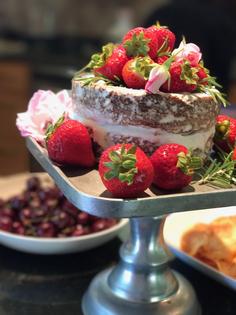Seriously Simple: Naked cakes are elegant and Seriously Simple
Michelle Heston is a colleague of mine I have known for many years. She is a seasoned public relations director for the Fairmont Hotels in San Francisco. For the last few years I have been watching her posts on Facebook, noting that they were nothing about hotels but instead beautiful cakes.
I recently caught up with her to find out how this transition had taken place. In fact, it isn't a transition but an addition to her busy work life. She needed to relieve some stress, so she started baking and decorating elegant cakes. When she started baking she found it to be creative and meditative. And then she discovered how happy it made her recipients to have been given a personal and delicious gift.
I asked her to share some of her secrets for a Seriously Simple take on cake baking and frosting. While she often makes cakes from scratch, she suggests starting with a cake mix. She is also a big fan of naked cakes, which have light frosting on the sides. Frosting a naked cake is an elegant, simple and easy technique for most to master. I, too, love the look of these "naked cakes" that offer the baker a chance to be creative with the garnish on top.
Here are Michelle's tips for success:
How to take a box cake mix from ho hum to home run!
1. Start with a national brand cake mix (please don't skimp on a grocery store brand here) and tweak box directions.
2. Substitute vegetable oil for butter.
3. Substitute water for either milk or a combination of milk and liquor (rum, Kahlua, brandy). If you're making a chocolate cake, replace a couple tablespoons of the aforementioned liquid with strong coffee. Coffee really takes chocolate to the next level.
4. Add an additional teaspoon of vanilla extract.
5. Add an extra egg.
6. Don't buy store-bought frosting; the texture is never quite right. Spend the time making a quality frosting.
Michelle's Stand-by Frosting
Yields enough to frost a 9-inch two-layer cake
4 cups powdered sugar (or 1 pound)
1 cup butter (softened salted sweet cream)
2 to 3 teaspoons vanilla or almond extract
1 to 2 tablespoons milk, buttermilk or coconut milk
1. In medium bowl, mix powdered sugar and butter with spoon or an electric mixer on low speed. Stir in vanilla (or other extract) and 1 tablespoon of the milk.
2. Gradually beat in just enough remaining milk to make frosting smooth and spreadable. If frosting is too thick, beat in more milk, a few drops at a time.
How to "naked" frost a cake
1. Pan prep is crucial.
Since the sides are exposed, be sure to be conscious of how you prepare your cake pans before baking. I use a non-stick spray and line the pans with parchment paper for all my cakes. Let cakes cool about 10 to 15 minutes on a wire rack (or long enough that you can safely handle the cake pans without oven mitts) before removing them from their pans.
2. Fill and stack with care.
Carefully cut and trim your cakes into level layers with a long serrated knife. Before cutting, it is best to wrap a cooled cake in a double layer of plastic or a gallon-sized Ziploc bag and then chill it in the fridge for about two hours (or up to a couple days). Chilling the cake is imperative, as it will help keep the cake from crumbling and/or splitting.
3. Make a dam to frost the cake.
Make a frosting dam to create clean, even layers, as well as to contain any softer fillings that may be used. Fill a piping bag fitted with a medium round tip with frosting, and pipe a ring around the top edge of each layer. Try to pipe this ring as even as possible -- using the opening of the piping tip as a guide to how thick the filling layer should be (I usually use about a 1/2-inch opening). Pipe the frosting slightly away from the very edge of the cake to allow some space for the frosting to shift and squeeze out a bit as the cake layers are stacked on top of each other.
Fill the dam with your filling of choice, and repeat with the remaining layers. If you are using softer fillings like lemon curd or fruit preserves, then using a frosting dam is always my suggestion.
Save a bottom layer for last, and stack it upside down. Use the naturally flat bottom as the top of your cake to keep things level.
How bare do you go?
It's a personal preference. I tend to go with partial crumb coat. I like that the top of the cake gets a decent amount of frosting (making a great canvas for decorations), while the sides get a few random patches to create a rustic look. Try using a small off-set spatula to direct where you want the frosting to go, or even fill in any gaps with leftover frosting from your piping bag.
Dress it up
Dressing up a naked cake is my favorite part. Gather inspiration from your gardens and/or crisper drawer. I love to incorporate seasonal flowers and fruits, and I try to give a hint at some of the flavors that are inside the cake. Other times I just let loose and throw on whatever I think looks good. Try topping with seasonal (edible) flowers and herbs, fresh berries, shaved coconut or chocolate.
(Diane Rossen Worthington is an authority on new American cooking. She is the author of 18 cookbooks, including "Seriously Simple Parties," and a James Beard Award-winning radio show host. You can contact her at www.seriouslysimple.com.)







